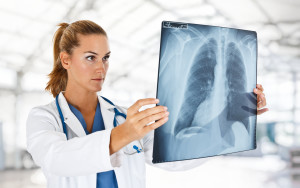What Women Need to Know About Lung Cancer
 Lung Cancer is The Number One Cancer Killer of Women
Lung Cancer is The Number One Cancer Killer of Women
Every year, cancer claims the lives of over a quarter of a million women. Of all types of cancer, lung cancer is the number one killer of women, having surpassed breast cancer in 1987. Women of all ages should familiarize themselves with the causes and risk factors of lung cancer. With proper education, routine screenings, and a healthy lifestyle, women can reduce their risk of falling victim this deadly disease.
According to The American Lung Association, the rate of new lung cancer cases over the past 37 years has dropped 28 percent for men, but has risen 98 percent for women. Smoking contributes to 80 percent of lung cancer deaths in women. Cigarette smoke specifically causes the greatest lung cancer risk, and though the risk is not as high, pipe and cigar smoke exposure can also increase the risk of lung cancer. Women who smoke are 13 times more likely to develop lung cancer compared to women who have never smoked, with the risk of lung cancer increasing with every cigarette smoked over time.
There is a misconception that all lung-cancer cases are the result of smoking, but in reality one in five women diagnosed with lung cancer has never smoked. However, one of the greatest risk factors of lung cancer for non-smokers is exposure to second-hand smoke. Non-smokers have a 20-30 percent greater chance of developing lung cancer if they are exposed to secondhand smoke at home or work. Still, there are other non-tobacco related factors that can increase the risk of developing lung cancer.
Studies point to genetics, the presence of certain lung diseases such as chronic obstructive pulmonary disease (COPD), environmental factors such as air pollution, and exposure to hazardous materials such as radon, uranium, arsenic, nickel and chemicals like asbestos, as non-tobacco risk factors for developing lung cancer. Regardless of whether they smoke, women should know the signs of lung cancer and should make an appointment for a screening if they suspect their symptoms may be indicative of a serious condition. Lung cancer symptoms may include coughing, wheezing, shortness of breath, and bloody mucus.
The most important step that a woman can take to reduce her risk of lung cancer is to stop smoking. Once a woman has stopped smoking, her risk of developing lung cancer decreases annually as normal lung cells grow and replace damaged cells. Approximately 15 years after quitting, a woman’s risk of developing lung cancer will more closely mirror that of a life-long non-smoker. For those who are non-smokers, but are exposed to tobacco smoke from a family member or from a work environment, minimizing exposure to second hand smoke can help mitigate the risk of contracting the disease. If you think that your home or work environment may be exposing you to asbestos or radon gas, have your environment tested right away.
Living smoke-free, and maintaining a safe home and work environment free from hazardous materials, and knowing the signs and symptoms of the disease, are important steps to staying cancer-free. With proper preventive measures and early detection, women can reduce their risk of lung and other types of cancer.
At Western New York OBGYN we are committed to your health and well-being. If you are looking for a top OBGYN practice and live in the Buffalo area, give us a call, we are accepting new patients.
